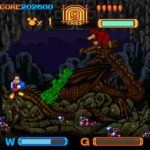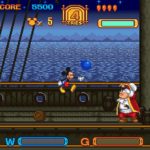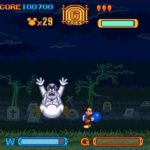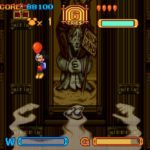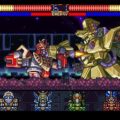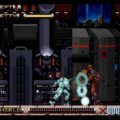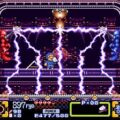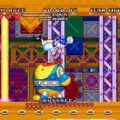Developer: Graphic Research Company Publisher: Tomy Released: 12/16/94 Genre: Action
Here in the West the Disney license one publisher would handle their titles per platform. Initially Sega did a fine job churning out gold for their systems with Virgin carrying the flag soon after. Capcom would do right by Nintendo owners and would eventually pass the torch to Virgin as well. But over in Japan it was open season as anyone who could afford it was given free reign. That led to quite the variety of games that never left the country. Mickey no Tokyo Disneyland Daibouken is the product of Graphic Research Company; I don’t know who they are but they have done a bang up job creating an alternative to Capcom’s Magical Quest games without using the same mechanics.
On a routine trip to Tokyo Disneyland Mickey finds out that his friends have been kidnapped and Pete has taken over. With nothing but a backpack full of water, air and some balloons Mickey must set things right. Since the game takes place completely within Tokyo Disneyland it reminds me of Adventures in the Magic Kingdom. Except this game is not so average. Mickey no Tokyo Disneyland Daibouken makes excellent use of its play mechanics to create an adventure that rivals Capcom’s works. It also requires no Japanese knowledge to enjoy.
Seeing Mickey Mouse with two balloon tanks might look (okay it is) silly but it makes for some interesting gameplay opportunities. Your only means of offense are water balloons which can be thrown in an arc or filled with more water to inflict heavy damage. But they also serve numerous other functions as well. Water balloons can activate switches or act as a trampoline. If there is sufficient air pressure they can even function as makeshift platforms. Hell, if the temperature is cold enough the water can freeze and become solid.
The gas balloon sees just as much use as the water balloons and is just as varied. Inflating a balloon to its maximum will carry you aloft until the air runs out leading to a swift drop. By pressing in a direction and letting go you can send Mickey rocketing forth. The more helium in the balloon the farther you will travel. This mechanic has many subtle and creative uses. If you time it right you can use a boost to slide along the ground to find hidden items for example. Mastering the gas balloon is critical as the end game calls on it heavily. Luckily the first few levels ease you into the mechanic with little penalty of death.
There aren’t many enemies present so Mickey can spend more time using his abilities in pretty ways. For example there is a section in Big Thunder that features updrafts that will drag you back to the beginning. By placing full sized balloons as platforms you can cross. My personal favorite comes in the Haunted House where you must use your gas balloons to outrace a giant ghost to the top of the stage. The level design manages to keep up this level of ingenuity and is only let down by the less than responsive controls. There is a bit of input lag that is easy to ignore early on. Once you are need to time your boosts perfectly or even start to fill another balloon as soon as the previous ends it becomes a hassle. While not broken they do make an already difficult game harder.
In a surprising twist this game can actually be pretty challenging. Depending on the difficulty level you can sustain three, five, or eight hits which come pretty quickly. Initially you can find hearts everywhere but gradually they become less frequent. There’s a sharp difficulty spike in the last two stages and not in a good way. There is a heavy reliance on using the gas balloon to navigate bottomless pits of spikes which would normally be great. However here you must make frequent “leaps” of faith or such pinpoint accurate rocket boosts that it comes across as malicious rather than legitimately challenging.
As a late 1994 release Mickey no Tokyo Disneyland Daibouken features beautiful art and wonderfully animated sprites. The different attractions at Disneyland give the game a wide variety of themes to base its levels. They still occasionally fall into the standard platforming tropes however. I would still give the crown to the Magical Quest series however. But that is mainly because Capcom’s artists could go to town due to the fantasy world theme. Special effects are at a minimum; with the exception of one boss battle. Mode 7 is sees little use with the game instead using transparency heavily. The music is catchy but not all that memorable.
In Closing
Mickey Mouse and the 16-bit generation were a perfect match. Mickey no Tokyo Disneyland Daibouken stands alongside the Magical Quest games as excellent platformers for gamers of all stripes. The slight delay in the controls can be frustrating at times but isn’t a game breaker thankfully. There is very little spoken dialogue and it is not important anyway. If you can find a copy at a decent price go nuts.


